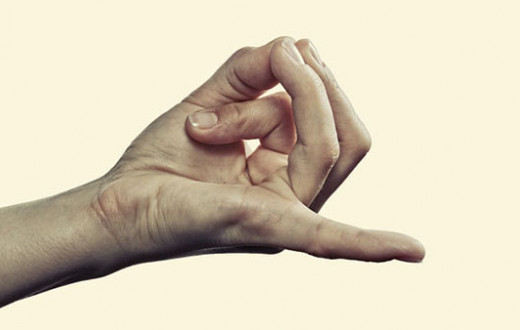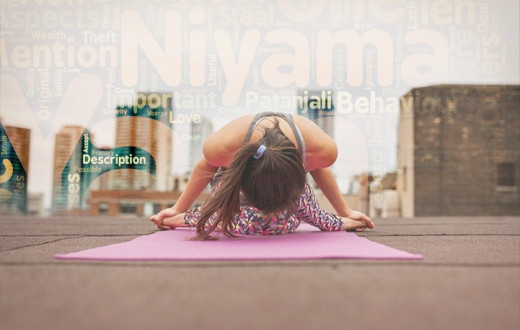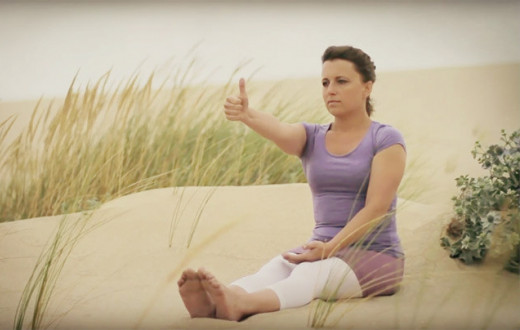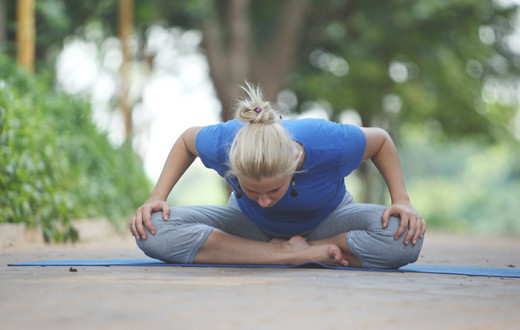As per Patanjali’s 8 Limbs of Yoga, Asana is the third limb, the first limb being Yamas and second limb being Niyamas. It makes sense, then, that the first two limbs must have some relevance to Asana practice. Superficially, there may not be an obvious connection, as theYamas are a social code of conduct, and the Niyamas are a standard of personal ethics an individual strives to follow on the spiritual sojourn of Yoga.
Patanjali explains how an asana should be practiced:
Sthir sukham asanam: An asana, or a pose, should be steady and comfortable. So how can Yamas and Niyamas help bring about an asana practice that is steady and comfortable?
Practicing Yamas on the mat:
1. Ahimsa (non-violence):
In an ordinary sense, we see violence only when it is directed toward others. Rarely does one look at himself or herself through an understanding of non-violence.
On the mat, Ahimsa means that you choose to honour and respect your own body and its ability to practice asanas, so that you will not hurt myself physically or mentally. It means that you make an effort to do what you can on the mat with sincerity, respecting the limits of you body.
This means that you will not over-stretch or strain your body, and at the same time, will do what you are able to with what capability you have. If an asana is done with this attitude, it can be the first step towards being still and steady in body, mind, and spirit, to reaching a place where there is no judgement as to your ability and no comparison with others. Because the body is not strained, and the effort is sincere, the mind is relaxed and the spirit free.
Ahimsa on the mat is a sincere effort that honours the body and calms the mind.
2. Satya (truth):
How can an understanding of truth help on the mat? What does truth on the mat look like?
Truth remains the same on the mat or off the mat. There is truth in the fact that everything is changing at every moment. There is truth in the fact that one’s body and mind change daily, even from moment to moment! If you allow yourself to be swayed by the changes in the body or changes in your thoughts, feelings, and opinions, then your asana practice cannot possibly remain steady and comfortable. Truth is also found in the thought that though everything changes, there is a part of you that is not changing. Your ability to stretch, lift, flex, and twist may improve as your practice becomes more intense and regular. These abilities of the body may also deteriorate as a result of illness, injury or aging. However, the understanding of a steady and comfortable asana can only continue to improve as you practice, so that you can transcend the body-mind attachment and discover the part of yourself that is unchanging
Satya on the mat is: Body, breath and mind belong to me and change with time and circumstances. Honouring these changes I aspire to rise beyond these changes to that part of me that is unaffected by the change.
3. Asteya (non-stealing):
What can you possibly steal on the mat?
Asteya on the mat comes in the form of losing patience, or attempting advanced asanas on the mat, when you have not sincerely learned the basics of a beginner practice. If you want to practice and look the same as an advanced yoga practitioner without applying sincere effort, that, too, is stealing. You might also practice for shorter periods of time on far fewer days of the week, and still expect to gain the physical and mental benefits of yoga practice.
This insincere attitude is stealing, wanting more than what you have earned. In this type of practice, you cannot possibly reap all the benefits of yoga practice, and may even end up with a physical injury that will prevent you from continuing your practice. If you continue to envy the advanced practitioner, you may be left with a feeling of failure or disappointment.
A strained body and a disturbed mind cannot possibly bring you to a state of a steady and comfortable asana.
Asteya on the mat is being non-judgemental, non-competitive, and measuring your growth only by self-comparison. You are your only competition!
4. Brahmacharya (celibacy or moving in infinity):
How can one practice Brahmacharya on the mat?
Brahmacharya has a more superficial meaning of celibacy, but a deeper meaning of becoming free from desire and abiding in the Brahman. Abiding in the Self.
If by practicing asanas, your intention is to develop a slim, trim, and sexy body, then asana practice will become nothing more than an exercise routine. However, a properly instructed asana practice will bring you to a deeper understanding of the Self.
With full awareness of the body that is properly balanced with a mind that flows effortlessly with the breath, the asana practice itself becomes a meditation.
Brahmacharya on the mat is a body that is balanced, and a mind that flows effortlessly with the breath, so that the spirit is free to soar the vast expanse of the sky.
5. Aparigraha (non-accumulation):
How does one practice non-accumulation on the mat?
You are practicing aparigraha when you simply have the confidence that with sincere effort and proper execution of instruction, you will be able to do the asana mindfully. That as your understanding of the asanas increases, even simple asanas will unfold their complexities and value for your wellbeing. Having the confidence and being content with your abilities at any given stage in your practice will open up the path towards higher learning.
Aparigraha on the mat is confidence and trust that you shall be given what you need as you continue to do your practice sincerely.
Practicing Niyamas on mat:
1. Shaucha (purity):
Cleanliness and tidiness in the outer environment and your own personal cleanliness keeps the mind from becoming cluttered and irritable. On the mat, if your mind becomes disturbed, then your body cannot focus on doing asana, and the whole practice becomes disturbed.
Deeper understanding of Shaucha is to understand that your body and mind influence each other both on the mat and off the mat. Taking care of each is important to achieve a steady and comfortable asana. Balance and symmetry can only be achieved if the mind is calm and the body flows with the breath.
Shaucha on the mat means personal and environmental cleanliness, together with calmness of the mind.
2. Santosha (contentment):
Santosha on the mat means your asana practice is happening with a relaxed attitude of the body and mind.
Accepting the body as it is in that moment without complaint, and having a mindful attitude toward the practice of asana. When the mind and body are both relaxed, then every movement is joyful and becomes an expression of happiness.
Santosha on the mat is a tension-free body and a joyful mind, both flowing in harmony with the breath.
3. Tapas (penance):
Tapas means willingly accepting adverse conditions without complaining, and this extends to your asana practice on the mat being met with a sincere attitude. Having patience and willingness to give the practice your sincere effort. This type of practice will develop endurance and stamina on the mat and build capacity for endurance off the mat.
Tapas on the Mat is accepting the challenge of practice with a sincere attitude.
4. Swadhyaya (self-study):
Self-study on the mat means observing one’s attitude, balance, symmetry, and sincerity, and from these observations, learning to improve your own practice at your own pace.
Swadhyaya on the mat means learning from Self-reflection.
5. Ishwar pranidhana (surrendering to higher power):
Ishwar pranidhana is invited to your practice by 100% just letting go of any anxiety on the mat. Once your sincere effort has been given to achieving symmetry and balance on the mat, let the mind and body totally relax.
This attitude drops any feverishness. It allows you to transcend the body into stillness and the mind into a deep silence. This allows the divinity within to prevail.
Or as Patanjali explains, “Prayatna Shaithalya vAnant Samapatti bhyam!”
Ishwar Pranidhana on the mat is letting the divinity within be your guide into the practice and allowing the divinity to prevail: It is the journey and the destination!
In fact, one needs to follow only one of the Yamas or Niyamas and all other Yamas and Niyamas will start to manifest. Not just on the mat, but also in life. Each Yama or Niyama holds a secret to leading one to the truth, and like all rivers merge in the ocean, each of the Yamas and Niyamas bring one to the depth of True Consciousness.
Asatoma sat gamay…
Dr. Bharti Verma, MA, MD, FCFP, 500H E-RYT, is President of Duffus Health Centre, Canada and is also affiliated with Department of family medicine Dalhousie University as Lecturer/preceptor. She is also a very senior Art of Living teacher and is Chairperson of Sri SriSchool of Yoga and also NYU Post Graduate Medical School approved Yoga-CME retreat facilitator.





























